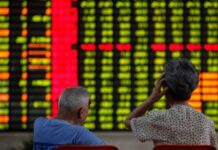
BEIJING: China urged the United States on Friday to “pull back from the brink” as President Donald Trump’s plans for tariffs on up to $60 billion in Chinese goods moved the world’s two largest economies closer to a trade war.
The escalating tensions between Beijing and Washington sent shivers through financial markets as investors foresaw dire consequences for the global economy if trade barriers start going up.
Trump is planning to impose the tariffs over what his administration says is misappropriation of U.S. intellectual property. A probe was launched last year under Section 301 of the 1974 U.S. Trade Act.
“China doesn’t hope to be in a trade war, but is not afraid of engaging in one,” the Chinese commerce ministry responded in a statement.
“China hopes the United States will pull back from the brink, make prudent decisions, and avoid dragging bilateral trade relations to a dangerous place.”
In a presidential memorandum signed by Trump on Thursday, there will be a 30-day consultation period that only starts once a list of Chinese goods is published.
That effectively creates room for potential talks to address Trump’s allegations on intellectual property theft and forced technology transfers.
Though the White House has said the planned tariffs were a response to China’s “economic aggression”, Trump said he views China as “a friend”, and both sides are in the midst of negotiations. A Chinese commerce ministry official said both sides were in touch, and communication channels were smooth.
Meantime, China showed readiness to retaliate by declaring plans to levy additional duties on up to $3 billion of U.S. imports including fresh fruit, wine and nuts in response to imports tariffs Trump announced earlier this month on steel and aluminum, which were due to go into effect on Friday.
The inevitable fall in demand from a full-blown trade war would spell trouble for all the economies supplying the United States and China.
Feeling the chill, MSCI’s broadest index of Asia-Pacific shares outside Japan dropped 2.45 percent, tracking a large overnight fall in Wall Street shares, Shanghai shares shed 3.8 percent and Japan’s Nikkei lost 4.5 percent, while perceived safe havens such as government bonds gained.
Williams estimated that the $506 billion that China exported to the United States drove around 2.5 percent of its total gross domestic product, and the $50-60 billion targeted by the U.S. tariffs contributed just around 0.25 percent.
Trump, however, appears intent on fulfilling election campaign promises to reduce the record U.S. trade deficit with China. A commentary published by the official Xinhua news agency said the United States had adopted a “Cold War mentality”, and “panic” over China’s economic rise was driving Washington’s confrontational approach.
LOW HANGING FRUIT
Alarm over Trump’s protectionist leanings mounted earlier this month after he imposed hefty import tariffs on steel and aluminum under Section 232 of the 1962 U.S. Trade Expansion Act, which allows safeguards based on “national security”.
On Friday, Trump gave Canada, Mexico, Argentina, Australia, Brazil and South Korea and the European Union temporary exemptions. China was not exempted even though it was a far smaller supplier than Canada or South Korea.
Also omitted from the exemption list was U.S. ally Japan, though a government spokesman said Tokyo would press to be included. And Finance Minister Taro Aso expressed empathy with Washington regarding the importance of protecting intellectual property.
China’s retaliation against the U.S. tariffs on steel and aluminum appeared restrained.
Targeting $3 billion of U.S. imports, China has drawn a list of 128 U.S. products that could be hit with tariffs if the two countries are unable to reach an agreement on trade issues, the ministry said.
The commerce ministry said China was considering implementing measures in two stages: first the 15 percent tariff on 120 products including steel pipes, dried fruit and wine worth $977 million, and later, the higher 25 percent tariff on $1.99 billion of pork and recycled aluminum.
U.S. wine exports to China last year were $79 million, according to data from the U.S. Wine Institute, which represents Californian wine makers.
The fruit growers of California, Florida, Michigan and Washington all stood to lose as China’s list also included close to 80 fruit and nut products. U.S. exports of fruits, frozen juices and nuts to China amounted to $669 million last year, and it was the top supplier of apples, cherries, walnuts and almonds.






